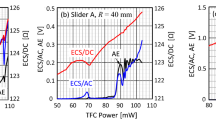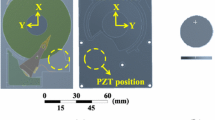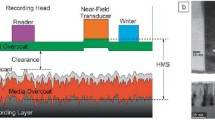Abstract
Inert gas filled head–disk interface (HDI) is a possible solution in reducing the magnetic spacing between the magnetic head and the magnetic media for achieving further increased recording density of a magnetic recording system. This article investigated the flying and thermal performances of a thermal actuated slider at inert gas filled HDI by using a couple-field analysis method which consists of a finite element model of the entire slider, an air bearing model based on the generalized lubrication equation and a heat transfer model which incorporates various molecular dynamics models and considers temperature effects. The simulation studies showed that the variation of gap flying height (FH) with the heater power in the inert gas is quite similar to that in air. It is also found that the slider’s thermal actuation efficiency in helium is slightly better than those in argon and air. However, the temperature effects in a fully sealed drive are totally different to those in an open drive. As a result, the inert gas filled HDI normally requires a larger thermal actuation stroke due to the temperature effects in a fully sealed drive.











Similar content being viewed by others
References
Aruga, K.: Japanese Patent Koukai Sho57-098164 (1982)
Bouchard, G., Talke, F.: Non-repeatable flutter of magnetic recording disks. IEEE Trans. Magn. 22(5), 1019–1021 (1988). doi:10.1109/TMAG.1986.1064437
Aruga, K., Suwa, M., Shimizu, K., Watanabe, T.: A study on positioning error caused by flow induced vibration using helium-filled hard disk drives. IEEE Trans. Magn. 43(9), 3750–3755 (2007). doi:10.1109/TMAG.2007.902983
Azarian, M.H., Bauer, C.L., O’Connor, T.M., Jhon, M.S.: Head-disk interaction in gas-lubricated slider bearings. Wear 168, 49–57 (1993). doi:10.1016/0043-1648(93)90198-U
Strom, B., Zhang, S., Lee, S., Khurshudov, A., Tyndall, G.: Effects of humid air on air-bearing flying height. IEEE Trans. Magn. 43(7), 3301–3304 (2007). doi:10.1109/TMAG.2007.897085
Liu, B., Yu, S.K., Zhou, W.D., Wong, C.H., Hua, W.: Low flying height slider with high thermal actuation efficiency and small flying height modulation caused by disk waviness. IEEE Trans. Magn. 44(1), 145–150 (2008). doi:10.1109/TMAG.2007.911036
Juang, J.Y., Bogy, D.B.: Air-Bearing effects on actuated thermal pole-tip protrusion for hard disk drives. ASME J. Tribol. 129, 570–578 (2007). doi:10.1115/1.2736456
Juang, J.Y., Chen, D., Bogy, D.B.: Alternate air bearing slider designs for areal density of 1 Tbit/in2. IEEE Trans. Magn. 42, 241–246 (2006). doi:10.1109/TMAG.2005.861739
Kurita, M., Xu, J., Tokuyama, M., Nakamoto, K., Saegusa, S., Maruyama, Y.: Flying-height reduction of magnetic head-slider due to thermal protrusion. IEEE Trans. Magn. 41, 3007–3009 (2005). doi:10.1109/TMAG.2005.855240
Song, S., Stoev, K., Fang, D., Gan, W., Rudman, V., Wang, J.: Pole tip protrusion of giant magnetic recording heads: simulation and experimental verification. J. Appl. Phys. 97, 10P303-1 (2005)
Yu, S.K., Liu, B., Hua, W., Zhou, W.D.: Contact-induced off-track vibrations of air bearing-slider-suspension system in hard disk drives. Tribol. Lett. 24, 27–36 (2006). doi:10.1007/s11249-006-9118-4
Zhou, W.D., Liu, B., Yu, S.K., Hua, W., Wong, C.H.: A generalized heat transfer model for thin film bearings at head-disk interface. Appl. Phys. Lett. 92, 043109 (2008). doi:10.1063/1.2838454
Zhou, W.D., Liu, B., Yu, S.K., Hua, W.: Conductive heat transfer in rarefied gas flow through micro/nano channels. DSI Technical Report, Singapore (2008)
Fukui, S., Kaneko, R.: Analysis of ultra-thin gas film lubrication based on linearized Boltzmann equation: first report-derivation of a generalized lubrication equation including thermal creep flow. ASME J. Tribol. 110, 335–341 (1988)
Fukui, S., Kaneko, R.: A database for interpolation of Poiseuille flow rates for high Knudsen number lubrication problems. ASME J. Tribol. 112, 78–83 (1990). doi:10.1115/1.2920234
Zhang, S., Bogy, D.B.: A heat transfer model for thermal fluctuations in a thin slider/disk air bearing. Int. J. Heat Mass Transf. 142, 1791–1800 (1999). doi:10.1016/S0017-9310(98)00267-1
Calvert, M., Baker, J.: Thermal conductivity and gaseous microscale transport. J. Thermophys. Heat Transf. 12, 138–145 (1998). doi:10.2514/2.6338
Sherman, F.S.: A survey of experimental results and methods for the transition regime of rarefied gas dynamics. Rarefied Gas Dyn. 2, 228–260 (1963)
White, F.M.: Viscous Fluid Flow. McGraw-Hill, Singapore (1991)
Bird, G.A.: Molecular Gas Dynamics and the Direct Simulation of Gas Flows. Oxford University Press, New York (1994)
Author information
Authors and Affiliations
Corresponding author
Rights and permissions
About this article
Cite this article
Zhou, W.D., Liu, B., Yu, S.K. et al. Inert Gas Filled Head–Disk Interface for Future Extremely High Density Magnetic Recording. Tribol Lett 33, 179–186 (2009). https://doi.org/10.1007/s11249-008-9405-3
Received:
Accepted:
Published:
Issue Date:
DOI: https://doi.org/10.1007/s11249-008-9405-3




